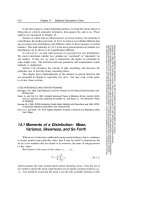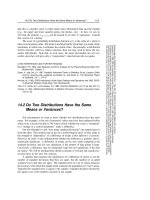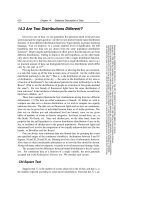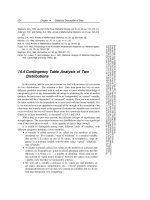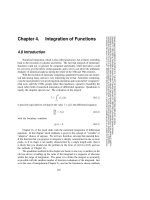Statistical Description of Data part 7
Bạn đang xem bản rút gọn của tài liệu. Xem và tải ngay bản đầy đủ của tài liệu tại đây (173.65 KB, 7 trang )
14.6 Nonparametric or Rank Correlation
639
Sample page from NUMERICAL RECIPES IN C: THE ART OF SCIENTIFIC COMPUTING (ISBN 0-521-43108-5)
Copyright (C) 1988-1992 by Cambridge University Press.Programs Copyright (C) 1988-1992 by Numerical Recipes Software.
Permission is granted for internet users to make one paper copy for their own personal use. Further reproduction, or any copying of machine-
readable files (including this one) to any servercomputer, is strictly prohibited. To order Numerical Recipes books,diskettes, or CDROMs
visit website or call 1-800-872-7423 (North America only),or send email to (outside North America).
sxy += xt*yt;
}
*r=sxy/(sqrt(sxx*syy)+TINY);
*z=0.5*log((1.0+(*r)+TINY)/(1.0-(*r)+TINY)); Fisher’s z transformation.
df=n-2;
t=(*r)*sqrt(df/((1.0-(*r)+TINY)*(1.0+(*r)+TINY))); Equation (14.5.5).
*prob=betai(0.5*df,0.5,df/(df+t*t)); Student’s t probability.
/* *prob=erfcc(fabs((*z)*sqrt(n-1.0))/1.4142136) */
For large n, this easier computation of prob, using the short routine erfcc, would give approx-
imately the same value.
}
CITED REFERENCES AND FURTHER READING:
Dunn, O.J., and Clark, V.A. 1974,
Applied Statistics: Analysis of Variance and Regression
(New
York: Wiley).
Hoel, P.G. 1971,
Introduction to Mathematical Statistics
, 4th ed. (New York: Wiley), Chapter 7.
von Mises, R. 1964,
Mathematical Theory of Probability and Statistics
(New York: Academic
Press), Chapters IX(A) and IX(B).
Korn, G.A., and Korn, T.M. 1968,
Mathematical Handbook for Scientists and Engineers
, 2nd ed.
(New York: McGraw-Hill),
§
19.7.
Norusis, M.J. 1982,
SPSS Introductory Guide: Basic Statistics and Operations
; and 1985,
SPSS-
X Advanced Statistics Guide
(New York: McGraw-Hill).
14.6 Nonparametric or Rank Correlation
It is precisely the uncertainty in interpreting the significance of the linear
correlation coefficient r that leads us to the important concepts of nonparametric or
rank correlation. As before, we are given N pairs of measurements (x
i
,y
i
). Before,
difficulties arose because we did not necessarily know the probability distribution
function from which the x
i
’s or y
i
’s were drawn.
The key concept of nonparametric correlation is this: If we replace the value
of each x
i
by the value of its rank among all the other x
i
’s in the sample, that
is, 1, 2, 3,...,N, then the resulting list of numbers will be drawn from a perfectly
known distribution function, namely uniformly from the integers between 1 and N,
inclusive. Better than uniformly, in fact, since if the x
i
’s are all distinct, then each
integer will occur precisely once. If some of the x
i
’s have identical values, it is
conventional to assign to all these “ties” the mean of the ranks that they would have
had if their values had been slightly different. This midrank will sometimes be an
integer, sometimes a half-integer. In all cases the sum of all assigned ranks will be
the same as the sum of the integers from 1 to N, namely
1
2
N(N +1).
Of course we do exactly the same procedure for the y
i
’s, replacing each value
by its rank among the other y
i
’s in the sample.
Now we are free to invent statistics for detecting correlation between uniform
sets of integers between 1 and N, keeping in mind the possibility of ties in the ranks.
There is, of course, some loss of information in replacing the original numbers by
ranks. We could construct some rather artificial examples where a correlation could
be detected parametrically (e.g., in the linear correlation coefficient r), but could not
640
Chapter 14. Statistical Description of Data
Sample page from NUMERICAL RECIPES IN C: THE ART OF SCIENTIFIC COMPUTING (ISBN 0-521-43108-5)
Copyright (C) 1988-1992 by Cambridge University Press.Programs Copyright (C) 1988-1992 by Numerical Recipes Software.
Permission is granted for internet users to make one paper copy for their own personal use. Further reproduction, or any copying of machine-
readable files (including this one) to any servercomputer, is strictly prohibited. To order Numerical Recipes books,diskettes, or CDROMs
visit website or call 1-800-872-7423 (North America only),or send email to (outside North America).
be detected nonparametrically. Such examples are very rare in real life, however,
and the slight loss of information in ranking is a small price to pay for a very major
advantage: When a correlation is demonstrated to be present nonparametrically,
then it is really there! (That is, to a certainty level that depends on the significance
chosen.) Nonparametric correlation is more robust than linear correlation, more
resistant to unplanned defects in the data, in the same sort of sense that the median
is more robust than the mean. For more on the concept of robustness, see §15.7.
As always in statistics, some particular choices of a statistic have already been
invented for us and consecrated, if not beatified, by popular use. We will discuss
two, the Spearman rank-order correlation coefficient (r
s
), and Kendall’s tau (τ).
Spearman Rank-Order Correlation Coefficient
Let R
i
be the rank of x
i
among the other x’s, S
i
be the rank of y
i
among the
other y’s, ties being assigned the appropriate midrank as described above. Then the
rank-order correlation coefficient is defined to be the linear correlation coefficient
of the ranks, namely,
r
s
=
i
(R
i
− R)(S
i
− S)
i
(R
i
− R)
2
i
(S
i
− S)
2
(14.6.1)
The significance of a nonzero value of r
s
is tested by computing
t = r
s
N − 2
1 − r
2
s
(14.6.2)
which is distributed approximately as Student’s distribution with N − 2 degrees of
freedom. A key point is that this approximation does not depend on the original
distribution of the x’s and y’s; it is always the same approximation, and always
pretty good.
It turns out that r
s
is closely related to another conventional measure of
nonparametric correlation, the so-called sum squared difference of ranks,definedas
D=
N
i=1
(R
i
− S
i
)
2
(14.6.3)
(This D is sometimes denoted D**, where the asterisks are used to indicate that
ties are treated by midranking.)
When there are no ties in the data, then the exact relation between D and r
s
is
r
s
=1−
6D
N
3
−N
(14.6.4)
When there are ties, then the exact relation is slightly more complicated: Let f
k
be
the number of ties in the kth group of ties among the R
i
’s, and let g
m
be the number
of ties in the mth group of ties among the S
i
’s. Then it turns out that
r
s
=
1 −
6
N
3
− N
D +
1
12
k
(f
3
k
− f
k
)+
1
12
m
(g
3
m
− g
m
)
1−
k
(f
3
k
− f
k
)
N
3
− N
1/2
1−
m
(g
3
m
− g
m
)
N
3
− N
1/2
(14.6.5)
14.6 Nonparametric or Rank Correlation
641
Sample page from NUMERICAL RECIPES IN C: THE ART OF SCIENTIFIC COMPUTING (ISBN 0-521-43108-5)
Copyright (C) 1988-1992 by Cambridge University Press.Programs Copyright (C) 1988-1992 by Numerical Recipes Software.
Permission is granted for internet users to make one paper copy for their own personal use. Further reproduction, or any copying of machine-
readable files (including this one) to any servercomputer, is strictly prohibited. To order Numerical Recipes books,diskettes, or CDROMs
visit website or call 1-800-872-7423 (North America only),or send email to (outside North America).
holds exactly. Notice that if all the f
k
’s and all the g
m
’s are equal to one, meaning
that there are no ties, then equation (14.6.5) reduces to equation (14.6.4).
In (14.6.2) we gave a t-statistic that tests the significance of a nonzero r
s
.Itis
also possible to test the significance of D directly. The expectation value of D in
the null hypothesis of uncorrelated data sets is
D =
1
6
(N
3
− N) −
1
12
k
(f
3
k
− f
k
) −
1
12
m
(g
3
m
− g
m
)(14.6.6)
its variance is
Var ( D )=
(N−1)N
2
(N +1)
2
36
×
1 −
k
(f
3
k
− f
k
)
N
3
− N
1−
m
(g
3
m
−g
m
)
N
3
−N
(14.6.7)
and it is approximately normally distributed, so that the significance level is a
complementary error function (cf. equation 14.5.2). Of course, (14.6.2) and (14.6.7)
are not independent tests, but simply variants of the same test. In the program that
follows, we calculate both the significance level obtained by using (14.6.2) and the
significance level obtained by using (14.6.7); their discrepancy will give you an idea
of how good the approximations are. You will also notice that we break off the task
of assigning ranks (including tied midranks) into a separate function, crank.
#include <math.h>
#include "nrutil.h"
void spear(float data1[], float data2[], unsigned long n, float *d, float *zd,
float *probd, float *rs, float *probrs)
Given two data arrays,
data1[1..n]
and
data2[1..n]
, this routine returns their sum-squared
difference of ranks as D, the number of standard deviations by which D deviates from its null-
hypothesis expected value as
zd
, the two-sided significance level of this deviation as
probd
,
Spearman’s rank correlation r
s
as
rs
, and the two-sided significance level of its deviation from
zero as
probrs
. The external routines
crank
(below) and
sort2
(§8.2) are used. A small value
of either
probd
or
probrs
indicates a significant correlation (
rs
positive) or anticorrelation
(
rs
negative).
{
float betai(float a, float b, float x);
void crank(unsigned long n, float w[], float *s);
float erfcc(float x);
void sort2(unsigned long n, float arr[], float brr[]);
unsigned long j;
float vard,t,sg,sf,fac,en3n,en,df,aved,*wksp1,*wksp2;
wksp1=vector(1,n);
wksp2=vector(1,n);
for (j=1;j<=n;j++) {
wksp1[j]=data1[j];
wksp2[j]=data2[j];
}
sort2(n,wksp1,wksp2); Sort each of the data arrays, and convert the entries to
ranks. The values sf and sg return the sums
(f
3
k
−f
k
)
and
(g
3
m
− g
m
), respectively.
crank(n,wksp1,&sf);
sort2(n,wksp2,wksp1);
crank(n,wksp2,&sg);
*d=0.0;
for (j=1;j<=n;j++) Sum the squared difference of ranks.
*d += SQR(wksp1[j]-wksp2[j]);
642
Chapter 14. Statistical Description of Data
Sample page from NUMERICAL RECIPES IN C: THE ART OF SCIENTIFIC COMPUTING (ISBN 0-521-43108-5)
Copyright (C) 1988-1992 by Cambridge University Press.Programs Copyright (C) 1988-1992 by Numerical Recipes Software.
Permission is granted for internet users to make one paper copy for their own personal use. Further reproduction, or any copying of machine-
readable files (including this one) to any servercomputer, is strictly prohibited. To order Numerical Recipes books,diskettes, or CDROMs
visit website or call 1-800-872-7423 (North America only),or send email to (outside North America).
en=n;
en3n=en*en*en-en;
aved=en3n/6.0-(sf+sg)/12.0; Expectation value of D,
fac=(1.0-sf/en3n)*(1.0-sg/en3n);
vard=((en-1.0)*en*en*SQR(en+1.0)/36.0)*fac; and variance of D give
*zd=(*d-aved)/sqrt(vard); number of standard devia-
tions and significance.*probd=erfcc(fabs(*zd)/1.4142136);
*rs=(1.0-(6.0/en3n)*(*d+(sf+sg)/12.0))/sqrt(fac); Rank correlation coefficient,
fac=(*rs+1.0)*(1.0-(*rs));
if (fac > 0.0) {
t=(*rs)*sqrt((en-2.0)/fac); and its t value,
df=en-2.0;
*probrs=betai(0.5*df,0.5,df/(df+t*t)); give its significance.
} else
*probrs=0.0;
free_vector(wksp2,1,n);
free_vector(wksp1,1,n);
}
void crank(unsigned long n, float w[], float *s)
Given a sorted array
w[1..n]
, replaces the elements by their rank, including midranking of ties,
and returns as
s
the sum of f
3
− f ,wherefis the number of elements in each tie.
{
unsigned long j=1,ji,jt;
float t,rank;
*s=0.0;
while (j < n) {
if (w[j+1] != w[j]) { Not a tie.
w[j]=j;
++j;
} else { Atie:
for (jt=j+1;jt<=n && w[jt]==w[j];jt++); How far does it go?
rank=0.5*(j+jt-1); This is the mean rank of the tie,
for (ji=j;ji<=(jt-1);ji++) w[ji]=rank; so enter it into all the tied
entries,t=jt-j;
*s += t*t*t-t; and update s.
j=jt;
}
}
if (j == n) w[n]=n; If the last element was not tied, this is its rank.
}
Kendall’s Tau
Kendall’s τ is even more nonparametric than Spearman’s r
s
or D. Instead of
using the numerical difference of ranks, it uses only the relative ordering of ranks:
higher in rank, lower in rank, or the same in rank. But in that case we don’t even
have to rank the data! Ranks will be higher, lower, or the same if and only if
the values are larger, smaller, or equal, respectively. On balance, we prefer r
s
as
being the more straightforward nonparametric test, but both statistics are in general
use. In fact, τ and r
s
are very strongly correlated and, in most applications, are
effectively the same test.
To define τ , we start with the N data points (x
i
,y
i
). Now consider all
1
2
N(N − 1) pairs of data points, where a data point cannot be paired with itself,
and where the points in either order count as one pair. We call a pair concordant
14.6 Nonparametric or Rank Correlation
643
Sample page from NUMERICAL RECIPES IN C: THE ART OF SCIENTIFIC COMPUTING (ISBN 0-521-43108-5)
Copyright (C) 1988-1992 by Cambridge University Press.Programs Copyright (C) 1988-1992 by Numerical Recipes Software.
Permission is granted for internet users to make one paper copy for their own personal use. Further reproduction, or any copying of machine-
readable files (including this one) to any servercomputer, is strictly prohibited. To order Numerical Recipes books,diskettes, or CDROMs
visit website or call 1-800-872-7423 (North America only),or send email to (outside North America).
if the relative ordering of the ranks of the two x’s (or for that matter the two x’s
themselves) is the same as the relative ordering of the ranks of the two y’s (or for
that matter the two y’s themselves). We call a pair discordant if the relative ordering
of the ranks of the two x’s is opposite from the relative ordering of the ranks of the
two y’s. If there is a tie in either the ranks of the two x’s or the ranks of the two
y’s, then we don’t call the pair either concordant or discordant. If the tie is in the
x’s, we will call the pair an “extra y pair.” If the tie is in the y’s, we will call the
pair an “extra x pair.” If the tie is in both the x’s and the y’s, we don’t call the pair
anything at all. Are you still with us?
Kendall’s τ is now the following simple combination of these various counts:
τ =
concordant− discordant
√
concordant + discordant + extra-y
√
concordant + discordant + extra-x
(14.6.8)
You can easily convince yourself that this must lie between 1 and −1, and that it
takes on the extreme values only for complete rank agreement or complete rank
reversal, respectively.
More important, Kendall has worked out, from the combinatorics, the approx-
imate distribution of τ in the null hypothesis of no association between x and y.
In this case τ is approximately normally distributed, with zero expectation value
and a variance of
Var ( τ )=
4N+10
9N(N−1)
(14.6.9)
The following program proceeds according to the above description, and
therefore loops over all pairs of data points. Beware: This is an O(N
2
) algorithm,
unlike the algorithm for r
s
, whose dominant sort operations are of order N log N.If
you are routinely computing Kendall’s τ for data sets of more than a few thousand
points, you may be in for some serious computing. If, however, you are willing to
bin your data into a moderate number of bins, then read on.
#include <math.h>
void kendl1(float data1[], float data2[], unsigned long n, float *tau,
float *z, float *prob)
Given data arrays
data1[1..n]
and
data2[1..n]
, this program returns Kendall’s τ as
tau
,
its number of standard deviations from zero as
z
, and its two-sided significance level as
prob
.
Small values of
prob
indicate a significant correlation (
tau
positive) or anticorrelation (
tau
negative).
{
float erfcc(float x);
unsigned long n2=0,n1=0,k,j;
long is=0;
float svar,aa,a2,a1;
for (j=1;j<n;j++) { Loop over first member of pair,
for (k=(j+1);k<=n;k++) { and second member.
a1=data1[j]-data1[k];
a2=data2[j]-data2[k];
aa=a1*a2;
if (aa) { Neither array has a tie.
++n1;


